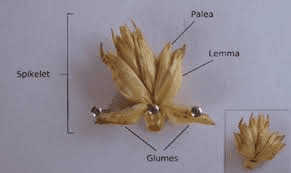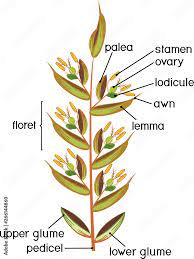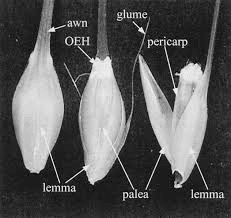The millet palea is one of the critical structures in the millet spikelet, which plays a significant role in protecting and supporting the developing seeds. It is one of two bracts, the other being the lemma, that enclose the floret within the spikelet.
The palea is positioned above the lemma and is typically thinner and more delicate. Its primary function is to provide additional protection to the floret and the developing seed. In millet spikelets, the palea and lemma together form a protective enclosure that safeguards the seed from physical damage, pests, and environmental factors.
The structure of the palea is generally characterized by its membranous or semi-transparent nature, which can vary in texture and toughness among different millet species. The palea’s surface may be smooth or have small, fine hairs, depending on the species. Its role is crucial during the flowering and seed development stages, as it helps in creating a secure environment for fertilization and seed formation.
The size and shape of the palea can differ across millet species. For instance, in pearl millet (Pennisetum glaucum), the palea is usually relatively broad and contributes to the overall robustness of the spikelet. In contrast, species like finger millet (Eleusine coracana) may have a more slender palea, which aligns with its compact spikelet structure.
The development of the palea is influenced by genetic factors and environmental conditions. During the flowering period, the palea, along with the lemma, encloses the reproductive organs of the floret, including the stamens and pistil. This enclosure helps ensure that pollination is successful and that the fertilized ovules develop into seeds. The palea’s protection is crucial for the seed’s maturation and eventual harvest.
In agricultural practices, understanding the characteristics of the palea can help in breeding programs aimed at improving millet varieties. Traits such as the palea’s size, toughness, and protective qualities are considered when selecting for varieties with better resistance to pests and environmental stresses. Additionally, the palea’s structure can affect the ease of processing and milling the millet grain after harvest.
In summary, the millet palea is an essential component of the spikelet, providing protection and support to the developing seed. Its structure, which varies among millet species, plays a crucial role in safeguarding the floret during fertilization and seed development. Understanding the palea’s characteristics helps in breeding and improving millet varieties for better yield and resilience.
The Economic Importance and Uses of Millet Palea

1. Seed Protection: The palea is one of the outer layers of the millet seed that provides protection during the seed’s development and maturation.
2. Grain Quality: The presence of the palea affects the overall quality of the millet grain, contributing to its durability and storage life.
3. Livestock Feed: After the grain is separated from the palea, the remaining parts can be used as roughage in livestock feed, providing fiber and some nutrients.
4. Mulching Material: Millet palea can be used as mulch to help retain soil moisture, suppress weeds, and regulate soil temperature.
5. Compost Ingredient: The palea can be added to compost piles, where it decomposes and contributes to nutrient-rich compost for agricultural use.
6. Biofuel Production: Millet palea can be processed into biofuel, such as ethanol, contributing to renewable energy sources.
7. Erosion Control: Used in erosion control practices, millet palea helps stabilize soil and prevent erosion by forming a protective layer on the soil surface.
8. Craft Materials: The palea can be used in crafting, including making natural decorations, woven items, or other ornamental products.
9. Soil Amendment: Decomposed millet palea adds organic matter and improves soil health, enhancing soil fertility and structure.
10. Animal Bedding: Dried millet palea can be used as bedding material for livestock, providing a comfortable and absorbent surface.
11. Carbon Sequestration: Millet palea contributes to carbon sequestration when used as biomass or incorporated into soil, helping mitigate climate change.
12. Biomass Energy: Millet palea can be used as biomass for energy production, providing a renewable source of heat and electricity.
13. Traditional Medicine: In some cultures, millet palea is used in traditional medicine for its purported health benefits.
14. Green Manure: The palea can be used as green manure, adding organic matter and nutrients to the soil when decomposed.
15. Packaging Material: Millet palea can be used as biodegradable packaging material, offering an eco-friendly alternative to plastic.
16. Soil Fertility Improvement: The decomposition of millet palea adds valuable nutrients to the soil, enhancing its fertility and promoting healthy plant growth.
17. Educational Uses: Millet palea can be used in educational settings to teach about plant anatomy, seed protection, and agricultural practices.
18. Feed Supplement: Millet palea can be included in feed mixes, providing additional fiber and nutrients to livestock diets.
Read Also: 19 Medicinal Health Benefits Of Polygonatum biflorum (Solomon’s Seal)
The Products and By-products That Can Be Derived From Millet Palea

1. Livestock Feed: After removing the grain, millet palea can be used as roughage in animal feed, providing fiber and nutrients.
2. Mulch: Millet palea can be used as mulch to help retain soil moisture, suppress weeds, and regulate soil temperature.
3. Compost: The palea can be added to compost piles, where it decomposes and contributes to nutrient-rich compost for gardening and farming.
4. Biofuel: Millet palea can be processed into biofuel, such as ethanol, contributing to renewable energy sources.
5. Craft Materials: The palea can be used in crafting for making natural decorations, woven items, and other ornamental products.
6. Soil Amendment: Decomposed palea improves soil health by adding organic matter and enhancing soil structure and fertility.
7. Animal Bedding: Dried millet palea is used as bedding material for livestock, providing a comfortable and absorbent surface.
8. Traditional Medicine: In some cultures, millet palea is used in traditional medicine for its potential health benefits.
9. Erosion Control: Millet palea helps stabilize soil in erosion control practices by forming a protective layer.
10. Carbon Sequestration: The palea contributes to carbon sequestration when used as biomass or incorporated into soil.
11. Biomass Energy: Millet palea is used as biomass for energy production, providing a renewable source of heat and electricity.
12. Green Manure: The palea can be used as green manure to enrich the soil with organic matter and nutrients.
13. Packaging Material: Millet palea can be used as biodegradable packaging material, offering an eco-friendly alternative to plastic.
14. Soil Fertility: The decomposition of millet palea adds valuable nutrients to the soil, enhancing its fertility.
15. Educational Purposes: Millet palea can be used in educational settings to demonstrate plant anatomy and agricultural practices.
16. Feed Supplement: The palea can be included in feed mixes to provide additional fiber and nutrients to livestock diets.
17. Biochar Production: Millet palea can be converted into biochar, which improves soil health and retains soil moisture.
Read Also: 7 Medicinal Health Benefits of Tongkat Ali (Eurycoma Longifolia)
Frequently Asked Questions (FAQ’s) About Millet Palea

1. What is a millet palea?
The millet palea is one of the outer layers of the millet seed that provides protection during its development and maturation.
2. How does the palea affect grain quality?
The palea contributes to the durability and storage life of the millet grain, affecting its overall quality.
3. Can millet palea be used in animal feed?
Yes, after the grain is separated, the remaining palea can be used as roughage in livestock feed.
4. How is palea used in mulching?
Millet palea can be used as mulch to help retain soil moisture, suppress weeds, and regulate soil temperature.
5. Are millet palea suitable for composting?
Yes, millet palea can be added to compost piles, where it decomposes and contributes to nutrient-rich compost.
6. Can palea be used for biofuel production?
Yes, millet palea can be processed into biofuel, such as ethanol, contributing to renewable energy sources.
7. What role does millet palea play in erosion control?
The palea helps stabilize soil in erosion control practices by forming a protective layer on the soil surface.
8. Can millet palea be used in crafting?
Yes, millet palea can be used in crafting for making natural decorations, woven items, and other ornamental products.
9. How does millet palea benefit soil health?
Decomposed millet palea adds organic matter to the soil, improving soil fertility and structure.
10. Are millet palea used in traditional medicine?
In some cultures, millet palea is used in traditional medicine for its potential health benefits.






